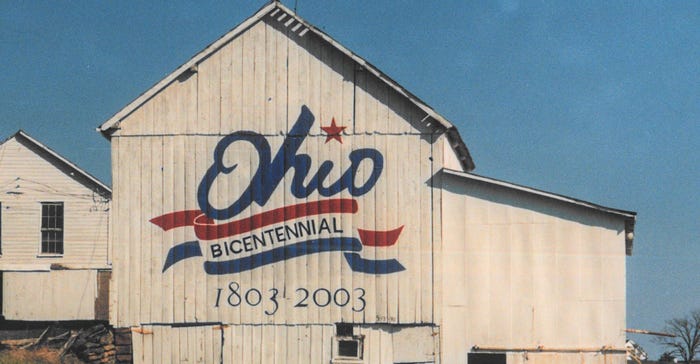November 6, 2020

Ohio took a page out of history at the end of the 20th century to prepare for its 200th anniversary of becoming the 17th state in the Union in 1803.
In the late 1700s, settlers started to push through Ohio, creating a gateway into the western wilderness. This is where the story of Ohio barns began, and it has continued to the present day.
The barns were built of virgin timber with great skill, reflecting craftsmanship from the Old World. The testify to the cultural traditions of families that stayed and farmed the rich Ohio soil, raised their families, formed communities and built cities. Barns are symbolic of the agricultural strength of the Buckeye State. So it was fitting that the Ohio Bicentennial Commission chose Ohio’s historic barns to be used as billboard barns of old to promote the celebration of its 200th year of statehood.
Barns were not hard to find, but it was difficult to choose just the right ones. The selected barn had to be in good condition, located on a well-traveled road. More than 2,000 barns vied for the honor of being the bicentennial barn in their county.
Barn painters with artistic talent are harder to find. As it happened, a barn painted with the Ohio State University buckeye logo by a young man from Belmont County had just been featured in a local newspaper. Scott Hagan, then 21 years old and a self-trained painter, was contacted and eventually signed a contract in 1997 with the Ohio Bicentennial Commission to paint the bicentennial logo on several barns for the upcoming celebration. The project soon expanded to painting one barn in each of the 88 counties and stretched over a period of five years, ending with the last barn painted in September of 2002.
A following
When a schedule of dates for the first barns to be painted was released, Hagan started to gain a following. People would drive for miles, bringing lawn chairs and picnics to watch him perform his magic with a brush and three colors of paint.
Hagan started by looking over the side of the barn to be painted and deciding where to position the large logo. Meticulously, he sketched the logo with painter’s chalk. It took several trips up and down the scaffold for a better perspective and to visualize the art that would come to life.
No two logos are the same. Hagan sketched each as an individual 20-by-20-foot piece of art. The early logos incorporated the outline of the state of Ohio, which was dropped later in the program.
Finally, it was time to prepare the paint and select the brushes. Blue was applied first, carefully following the chalked lines, then filling in the letter or shape. The logo started to unfold like the blooming of a beautiful flower. The whole process took a couple of days to complete.
5-year process
Throughout the five-year process, Hagan painted 30 red barns, 54 white, four brown and one yellow barn using 645 gallons of paint. He drove 65,000 miles in pursuit of painting the 88 barns. The first, in 1997, was in his own home county of Belmont. The bicentennial barn-painting ended in September 2002 with the Sandusky County barn, on the county fairgrounds in Fremont. It was the only logo to be painted on the barn roof. At last count, 10 bicentennial logo barns have been painted or sided over, or have been destroyed or demolished. Others have faded over the years. The bicentennial project not only caught and held the imagination of the citizens of Ohio, but was noted across the nation as well.
For more information and interesting reading on Ohio’s bicentennial barns, I recommend “Bicentennial Barns of Ohio,” a book by Christina Wilkinson. It’s available at Amazon at bit.ly/ohiobarnbook.
Each barn has its own story to tell.
Hagan specializes in painting larger-than-life designs on most any kind of structure. His goal is to paint in every state. So far, his state total is 18. He can be contacted through his website, barnartist.com.
Gray, “the lady barn consultant,” wants to hear your barn story. Contact her at [email protected] or 740-263-1369.
You May Also Like




